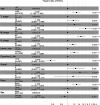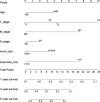A modified survival model for patients with esophageal squamous cell carcinoma based on lymph nodes: A study based on SEER database and external validation
- PMID: 36157416
- PMCID: PMC9489949
- DOI: 10.3389/fsurg.2022.989408
A modified survival model for patients with esophageal squamous cell carcinoma based on lymph nodes: A study based on SEER database and external validation
Abstract
Background: The counts of examined lymph nodes (ELNs) in predicting the prognosis of patients with esophageal squamous cell carcinoma (ESCC) is a controversial issue. We conducted a retrospective study to develop an ELNs-based model to individualize ESCC prognosis.
Methods: Patients with ESCC from the SEER database and our center were strictly screened. The optimal threshold value was determine by the X-tile software. A prognostic model for ESCC patients was developed and validated with R. The model's efficacy was evaluated by C-index, ROC curve, and decision curve analysis (DCA).
Results: 3,629 cases and 286 cases were screened from the SEER database and our center, respectively. The optimal cut-off value of ELNs was 10. Based on this, we constructed a model with a favorable C-index (training group: 0.708; external group 1: 0.687; external group 2: 0.652). The model performance evaluated with ROC curve is still reliable among the groups. 1-year AUC for nomogram in three groups (i.e., 0.753, 0.761, and 0.686) were superior to that of the TNM stage (P < 0.05). Similarly, the 3-year AUC and the 5-year AUC results for the model were also higher than that of the 8th TNM stage. By contrast, DCA showed the benefit of this model was better in the same follow-up period.
Conclusion: More than 10 ELNs are helpful to evaluate the survival of ESCC patients. Based on this, an improved model for predicting the prognosis of ESCC patients was proposed.
Keywords: decision curve analysis; esophageal squamous cell carcinoma; examined lymph nodes; nomogram; prognosis.
© 2022 Yang, Huang, Chen, Chen and Liang.
Conflict of interest statement
The authors declare that the research was conducted in the absence of any commercial or financial relationships that could be construed as a potential conflict of interest.
Figures








References
LinkOut - more resources
Full Text Sources

